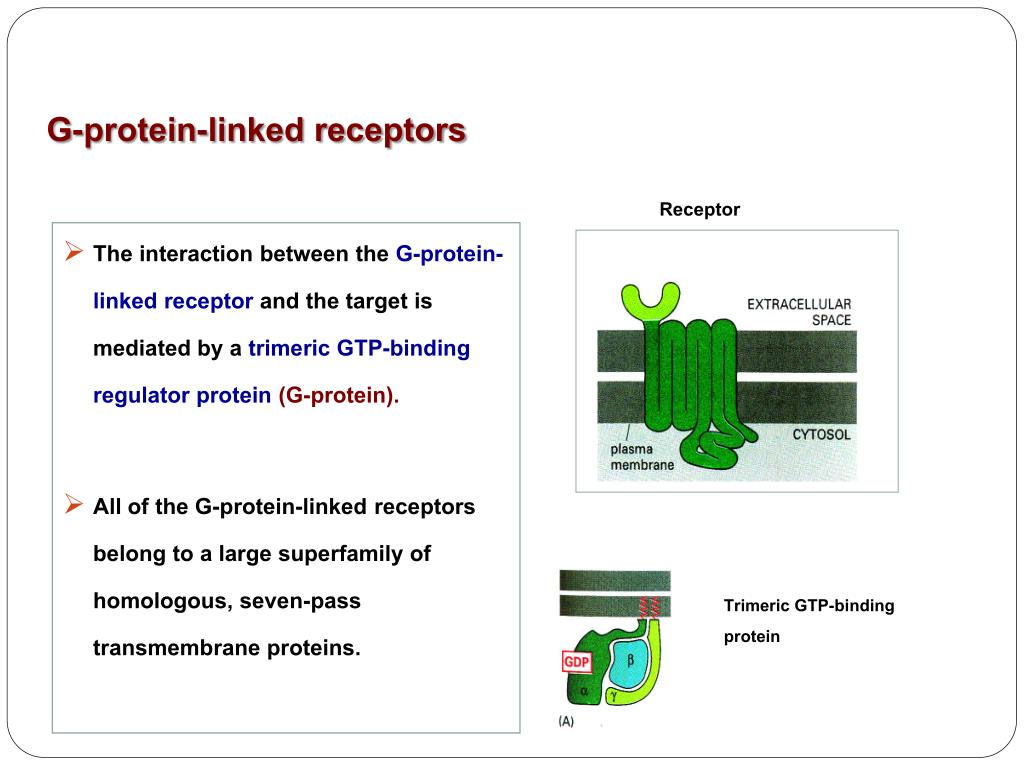

GDP increases the α-subunit’s affinity for the βγ-subunit, allowing reformation of the heterotrimeric complex of the G-protein. GTPase catalyses the breakdown of GTP on the α-subunit into GDP + Pi. To prevent excess signalling, GPCR activity can be switched off. Figure 2 - Sequence following GPCR ligand binding Furthermore, one GPCR can be associated with many G proteins, hence one signal can have many downstream cellular reactions. This allows for many GPCR combinations created by different receptors being coupled with G proteins comprised of different subunits. There are also many different types of α-, β- and γ-subunits. Common examples of GPCRs include adrenoreceptors, muscarinic acetylcholine receptors and opioid receptors. There are hundreds of GPCRs in the genome and their receptors are activated by many signals such as neurotransmitters, hormones, ions, peptides and even photons in the retina. In its inactive state, GDP is bound to the α-subunit of the G-protein. The G-protein is heterotrimeric and is made up of three different subunits: alpha ( α), beta ( β) and gamma ( γ). Figure 1 - G protein structure and activation cascade IP3 opens calcium channels, causing a Ca 2+ efflux into the cytoplasmĭAG activates protein kinase C (PKC), which goes on to phosphorylate target proteins Stimulates phospholipase C, which cleaves PIP 2 in the cell membrane into IP 3 and DAG Inhibits PKA activation (cAMP-dependent protein kinase)

Inhibits adenylyl cyclase, which catalyses conversion of ATP to cyclic AMP Stimulates PKA activation (cAMP-dependent protein kinase), which goes on to phosphorylate target proteins Stimulates adenylyl cyclase, which catalyses conversion of ATP to cyclic AMP The ultimate effect of these proteins depends on the specific cell in which it is located. This goes on to impact a downstream effector, which then causes a cellular response. Each alpha-subunit stimulates an enzyme, which acts to either increase or decrease the concentration of a secondary messenger. There are several different types of G-protein that can be present in a GPCR, which vary based on their α -subunit. This creates a cascade response whereby one agonist binding to the GPCR can bring about the catalysis of many reactions ( signal amplification). ion channel opening or enzyme activity regulation.ĭespite the fact that one G-protein coupled receptor only contains one α-subunit, this can interact with several secondary messengers, which can in turn activate multiple enzymes and catalyse many reactions. These α-subunit interacts with its relevant effectors and cause downstream effects, e.g.This activates the G-protein, causing the α-subunit and bound GTP to dissociate from the transmembrane portion of the GPCR and βγ-subunit.Released GDP is then replaced with a GTP.Binding at the extracellular ligand binding site causes a conformational change in the GPCR, resulting in release of GDP from the α-subunit of the G-protein.Ligands bind to the extracellular portion of the G-protein coupled receptor, binding either at the N-terminus or a binding site within the transmembrane region.For G-protein coupled receptors, this consists of 5 main steps.

An agonist (ligand) is a substance which binds to a receptor and brings about a cellular response.


 0 kommentar(er)
0 kommentar(er)
